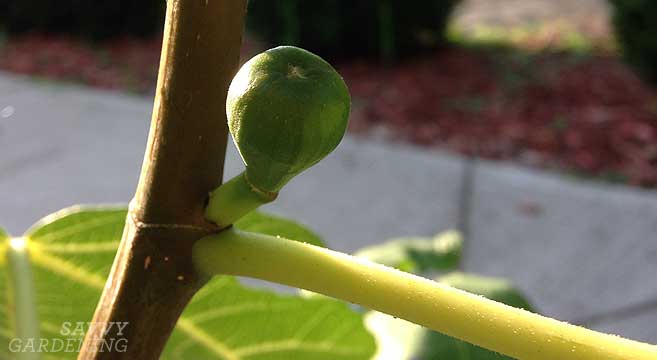This post may contain affiliate links. If you make a purchase through links on our site, we may earn a commission.
In the fall, sometimes it’s nice to bring some annuals indoors to keep as houseplants. However, my space for new indoor plants is limited, and I have to say my indoor green thumb isn’t quite as, um, proficient as my outdoor one. That’s why I like plants like figs and brugmansias. Overwintering plants that go dormant over the winter months, is a cinch. These no-fuss tropical plants won’t survive our harsh, Canadian winters, so they like to hunker down and hibernate, just like animals do.
This is called plant dormancy in the gardening world. To make plants go dormant, you need a cold, dark room where the plants will not freeze. I happen to have a weird little cold cellar room in my basement that is the perfect size for my fig tree (it’s a Verte that I got from fig expert Steven Biggs as a wee little twig) and a few other plants. A dark garage or shed, or uninsulated basement will also do the trick.

Overwintering plants that go dormant
When overwintering plants that go dormant, it’s important to keep an eye on the weather. For example, after harvesting the last of the figs in early fall, keep an eye on the weather. Wait until the fig tree leaves start turning yellow and dropping. If temperatures are really going to start to dip, bring the pot into an unheated garage where the rest of the leaves will drop. At this point you can give the pot one last light watering. The pot can then be brought indoors into a cold cellar for the winter. Check on the soil occasionally to make sure it’s not too dry. It may need the odd spritz of water before spring.
Bringing dormant plants out of hibernation
In the spring, I’ll make sure all danger of frost has passed before bringing my fig tree back outside. Sometimes I’ll put it in the garage for a few days so it can readjust to the light gradually, rather than being placed in the full-on sunlight. Wilbur always comes out of the basement looking like a Charlie Brown Christmas tree. Most years I don’t think he’s made it. But with a little patience, eventually I start to see the promise of new leaf buds, and later on, wee little figs.
More tips on overwintering plants
- Overwintering Escargot Begonia indoors
- Take a cutting of plants to grow in water indoors
- How to care for a dormant Venus fly trap
- How to protect your hydrangea for the winter




I keep several house plants on my deck in summer, and bring them inside for the winter. I clean them up, remove debris, and give them a good dose of insecticidal soap first. One of the pkantscis my weeping fig bonsai that loves being outside. Also a Xmas cactus, and other plants whose name I do not know.
Tender perennial herbs such as rosemary and thyme spend the winter in my cold frame.
I have several plants that are tropical and they go out in my balcony for the summer. I live in Kansas city and the winters here can get to 4 below. This year I have several container plants outside on my balcony that I want to overwinter. I have a horseradish and two licorice roots and two echinacea.. What I want to know is Do I mulch and should I completely cover plants with mulch. I have heard yes and also no… We are expecting first real hard freeze in the next couple days.
I would suggest insulating the outside of the pot if you have to keep them out for the winter. Wrap the exterior of the pot in several layers of bubblewrap or surround the pot with a cylinder of chickenwire filled with leaves or straw. The most important thing is to insulate the roots and protect them from freeze-thaw cycles. You should not cover over the crown of the plant or it could lead to rot.
I received a dormant honeysuckle to give as a gift for Christmas . Will it come out of hibernation if I keep it inside, or do I need to keep it outside to keep it dormant?
I would suggest keeping it outdoors, even if you’re just temporarily sinking the pot somewhere in the garden.
I have propagated some black lace elderberry, they are pretty small and i live in zone 5. Can I store them in a cold frame or would it be better to bring them into my shed? Thank you!
It’s hard to say… you may want to shelter them in your shed if they are still small. You could also put some in the shed and some in the cold frame to ensure you have some success.
I have several rugosa roses in pots. Should I bring them indoors or leave outside?
Rugosas are very hardy and should do well in the pots. However, if you live in Zone 4 or colder, I suggest sinking the pots into the compost pile up to their rims to help insulate the roots. If you don’t have a compost pile, wrap the outside of the pots in a few layers of bubblewrap to insulate the roots. The tops of the plants should be left uncovered.